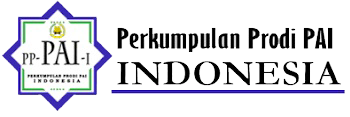Pemanfaatan Teknologi Informasi dan Komunikasi (TIK) dalam Pembelajaran Agama Islam Pada Abad 21
DOI:
https://doi.org/10.19109/pairf.v6i4.26143Keywords:
Untilization, Information And Communication Technology, Learning islamic ReligionAbstract
The paradigm shift in Islamic Religious Education refers to the learning approach that still applies conventional education. This research aims to find out the challenges of the 21st century for schools in Indonesia. In this article, the author will try to focus the discussion on the problems of Islamic education in Indonesia in the 21st century, challenges, and solutions in responding to the problems of Islamic education. The method used in the preparation of this article is a qualitative method. Then the approach in this research is to use literature studies and references in the form of books, journals, articles, and scientific works. Reflectively, this study wants to review existing ideas, treatments, and/or situations, especially about schools in the 21st century and their challenges. Based on the results of the review, it can be concluded that the challenges faced by schools in Indonesia in the 21st century are such as the mental revolution of teachers, equipping students who are born as digital natives with 21st-century skills, integrating the use of technology in learning, and curriculum reform according to 21st-century tastes.
References
Aufaa, Ruswan, and Agus Sutiyono. “‘Implementasi Prinsip-Prinsip Pembelajaran Abad 21 Pada Mata Pelajaran Pendidikan Agama Islam Dan Budi Pekerti (Studi Kasus Di SMA Negeri 2 Kendal),.’” Pijar: Jurnal Pendidikan Dan Pengajaran Vol.1, no. No.2 (2023): Hlm.86-97. https://doi.org/http://pijar.saepublisher.com/index.php/jpp/article/view/21.
Azhar, A Shohibatul. “Pemanfaatan Teknologi Informasi Dan Komunikasi Dalam Pembelajaran Pendidikan Agama Islam Di SMA N 1 Kawedanan Magetan.” IAIN Ponorogo, 2024. http://etheses.iainponorogo.ac.id/id/eprint/28076.
Jazuli, Okita Maya Asiyah and Muhammad Fahmi. “‘Inovasi Pembelajaran PAI Abad 21,.’” Ta’limDiniyah: Jurnal Pendidikan Agama Islam (Journal of Islamic Education Studies) Vol.2, no. No.2 (2022). https://doi.org/https://doi.org/10.53515/tdjpai.v2i2.33.
Masyithoh, Risda Lestari and Siti. “‘PROBLEMATIKA PENDIDIKAN ISLAM DI INDONESIA ABAD 21,.’” Al-Rabwah Vol.17, no. No.1 (2023). https://doi.org/https://doi.org/10.55799/jalr.v17i01.252.
Riyanto, Agus. “Guru Pendidikan Agama Islam Dimasa Teknologi Informasi Dan Komunikasi.” Al Kasyaf (Jurnal Pendidikan Dan Dakwah), 2023. https://jurnal.arrisalah-jakarta.com/index.php/alkasyafjpd/article/download/1/1.
Robbiy Maula Betaraya. “‘Pendidikan Agama Islam Berwawasan Teknologi (Ict),.’” Journal of Scientech Research and Development Vol.5, no. No.2 (2023). https://doi.org/https://doi.org/10.56670/jsrd.v5i2.186.
S. Djonnaidi, N. Wahyuni, and F. Nova. “Pengaruh Penerapan Media Poster Digital Dalam Pembelajaran Daring Di Masa Pandemi Terhadap Kemampuan Berbicara Siswa Di Politeknik Negeri Padang.” JINOTEP (Jurnal Inovasi Dan Teknologi Pembelajaran): Kajian Dan Riset Dalam Teknologi Pembelajaran 8, no. 1 (2021): 38–46. https://doi.org/10.17977/um031v8i12021p038.
Sahrul Sobirin, Mohammad Ihsan, and Wahab Wahab. “‘Pemanfaatan Aplikasi Dan Software Digital Terhadap Kebutuhan Evaluasi Pembelajaran Pendidikan Agama Islam,.’” EDUKASIA: Jurnal Pendidikan Dan Pembelajaran Vol.4, no. No.2 (2023). https://doi.org/https://doi.org/10.62775/edukasia.v4i2.662.
Sugiyono. Metode Penelitian Kuantitatif, Kualitatif, Dan R&D. CV Alfabeta, 2017.
———. Metodologi Penelitian Kualitatif. Bandung: Alfabeta, 2022.
Syarnubi, Syarnubi, Firman Mansir, Mulyadi Eko Purnomo, Kasinyo Harto, and Akmal Hawi. “‘Implementing Character Education in Madrasah.’” Jurnal Pendidikan Islam vol.7, no. no.1 (2021): hlm.77-94.
Syarnubi, Syarnubi. “‘Hakikat Evaluasi Dalam Pendidikan Islam’ 5 (2), 468-86.” Jurnal PAI Raden Fatah vol.5, no. no.2 (2023): hlm.468-486.
Syarnubi Syarnubi. “Penerapan Paradigma Integrasi-Interkoneksi Dalam Peningkatan Mutu Lulusan.” Jurnal PAI Raden Fatah 4, no. 4 (2022): 375–95.












.png)


1.png)



